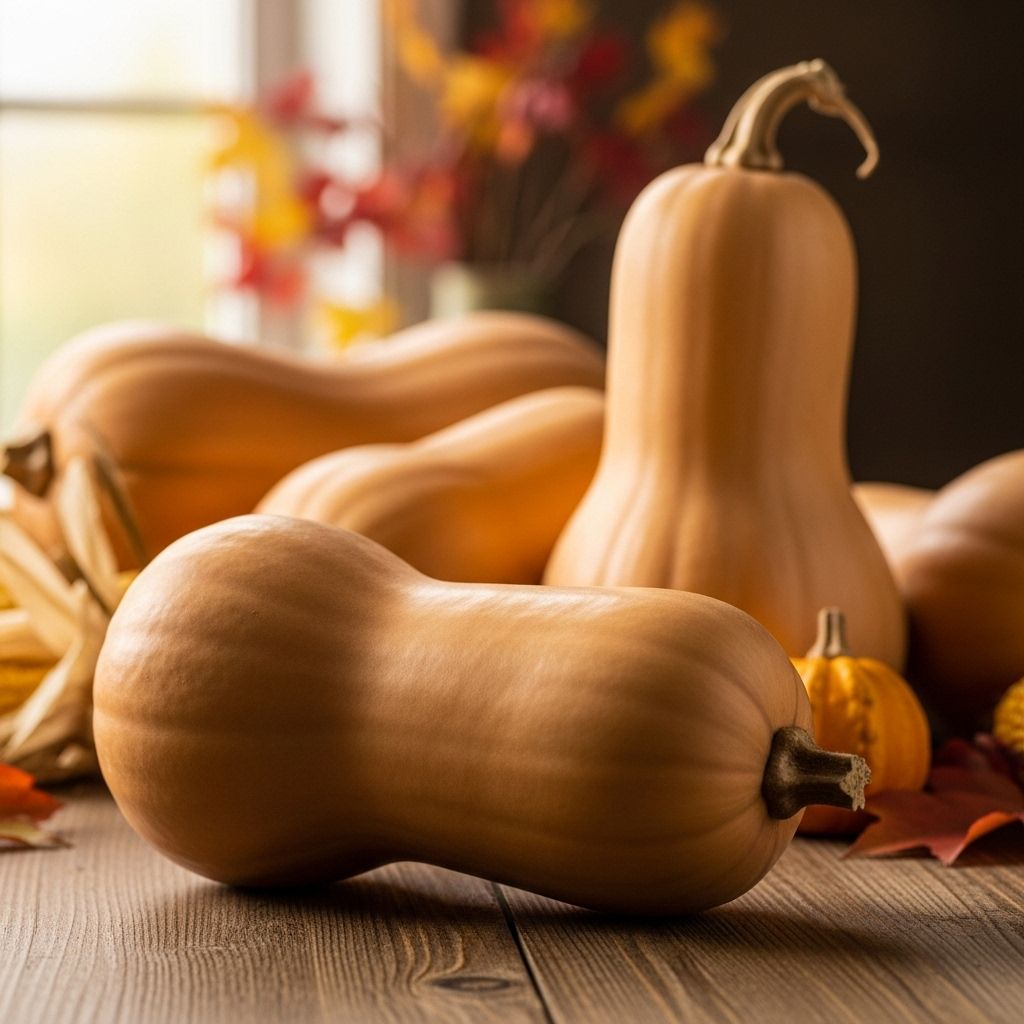Butternut Squash Harvest Time: 4 Key Ripeness Signs
Learn the perfect time and techniques for harvesting, curing, and storing butternut squash for top taste and long-lasting quality.

Image: HearthJunction Design Team
When to Harvest Butternut Squash: A Comprehensive Guide
Butternut squash is a beloved winter squash, valued for its sweet, nutty flesh and long storage life. Knowing exactly when to harvest your butternut squash is crucial for maximizing flavor, texture, and storage potential. This article provides a detailed look at harvesting, curing, and storing butternut squash, so you can enjoy the fruits of your labor through the winter and beyond.
The Best Time to Harvest Butternut Squash
The timing of your butternut squash harvest depends on the variety, planting date, and local climate. Generally, butternut squash requires 100 to 120 days from planting to maturity. This typically places harvest in late fall or early winter, but if you plant early, harvest may be possible as soon as late summer. Always pay attention to local weather patterns—especially the risk of frost, which can severely damage unharvested squash.
- Standard Maturity Window: 100–120 days after direct sowing.
- Traditional Harvest Time: Late fall to early winter.
- Early Planting: Possible harvest in late summer if planted in spring.
- Frost Warning: Always harvest before the first expected frost to prevent crop loss.
Tip: Even if your squash isn’t fully ripe, it’s better to harvest them the day before frost strikes than risk losing the whole crop to cold damage. Slightly underripe squash can be cured and eaten, though they may not store as long or develop full sweetness.
Timing Techniques
While the calendar provides a general guideline, several visual and tactile cues tell you precisely when your butternut squash is ready:
- Days to Maturity: Track days since planting for a rough estimate.
- Monitor Local Weather: Stay alert to frost forecasts and weather changes.
- Environmental Variability: Cool or hot weather can delay or speed up ripening, so observe your plants closely.
Frost as a Key Indicator
Frost is a critical cutoff point. Butternut squash vines and fruits do not tolerate frost. If a frost is forecasted, harvest all remaining fruits—ripe or unripe. Even brief exposure to freezing can destroy the sugars inside the fruits, causing rot and poor storage quality. Monitor local news and weather apps closely as autumn approaches.
Signs Butternut Squash is Ready to Harvest
Beyond timing, the squash itself gives several clear signals of ripeness. Use these checks to confirm your butternut squash is at its peak:
- Skin Color: The fruit’s skin turns a uniform matte tan, with no traces of green. Immature squash may have streaks or patches of green.
- Firmness: The skin should feel tough and resist piercing by a fingernail. If your nail leaves a mark easily, the squash isn’t mature.
- Stem Appearance: The stem connecting the squash to the vine dries out, hardens, and turns brown. When the plant stops sending nutrients, the fruit is ready.
- Fruit Size: Mature butternut squash will be full-sized for the variety, with a heavy feeling in hand.
| Ripening Indicator | How to Check |
|---|---|
| Skin Color | Uniform, deep tan with no green streaks |
| Skin Toughness | Cannot pierce with fingernail |
| Stem Dryness | Shriveled, brown, fully dry |
| Fruit Size | Variety-specific full size, feels heavy |
How to Harvest Butternut Squash
When signs of maturity are met, harvest your butternut squash using the following steps:
- Use Sharp Pruners or Shears: Avoid twisting or pulling the squash from the vine. A clean cut reduces the risk of damaging fruits or vines.
- Leave a Long Stem: Cut with at least 1 inch (2.5 cm) of stem attached. Leaving the stem intact prevents the entry of bacteria or mold during storage.
- Inspect for Damage: Discard or use immediately any fruits with cracks, bruises, or cuts; they won’t store well long-term.
- Handle Gently: Avoid dropping or knocking fruits together. Bruises can lead to premature spoilage.
The Importance of Curing Butternut Squash
Curing is a critical step that toughens squash skins, promotes sweetness, and extends storage life. Here’s how to do it:
- Place in a Warm, Dry Spot: Lay squash in a single layer in a location with good ventilation, out of direct sun. Ideal conditions are 80–85°F (27–29°C) and 80–85% humidity.
- Cure for 10–14 Days: Allow the squash to sit undisturbed for up to two weeks.
- Rotate Occasionally: Flip squash to expose all surfaces equally.
- Monitor for Problems: Remove any fruits with signs of rot.
After curing, the skin should be noticeably tougher, and the stem should be fully dry and corky. Curing also helps residual sugars develop, improving the finished flavor.
Storing Butternut Squash for Maximum Shelf Life
Proper storage ensures that you can enjoy homegrown butternut squash for months. Follow these guidelines:
- Choose the Right Location: Store in a cool, dry (ideally 50–55°F / 10–13°C) area, such as a basement, pantry, or unheated room.
- Air Circulation: Lay squash in a single layer, not touching, on shelves, crates, or slatted surfaces to encourage airflow.
- Check Regularly: Inspect every 2–3 weeks and remove any fruit starting to show signs of rot.
- Clean Before Storage (Optional): For long-term storage, wipe down cured squash with a weak bleach solution (1 tablespoon bleach per gallon of water) to kill mold spores and insect eggs. Dry thoroughly before storing.
Properly cured and stored butternut squash can last from 3 to 6 months, sometimes even longer. Use any squash with blemishes or wounds first, as perfect fruits will keep the longest.
Common Harvesting Mistakes (and How to Avoid Them)
- Harvesting Too Early: Immature squash will be bland and won’t store well. Wait for the full tan color and tough skin.
- Leaving in the Garden After Frost: Even one frost can ruin the crop. Harvest at the first frost warning, regardless of maturity.
- Cutting Too Close to the Fruit: A short or missing stem creates an entry for rot.
- Poor Curing: Skip curing and storage life drops significantly. Always cure for at least 10 days.
- Storing in Poor Conditions: Warm, damp, or airless locations lead to rapid spoilage.
Butternut Squash: Additional Tips for Successful Harvests
- Mulch and Soil Barriers: Place cardboard or straw under growing squash to prevent soil contact and reduce rot and pest damage.
- Pest Protection: Avoid wetting leaves during watering to prevent fungal diseases and attract fewer pests.
- Staggered Harvest: Not all squash will ripen at once. Harvest mature fruits as they’re ready to keep plants healthy and productive.
Table: Butternut Squash Harvest Timeline
| Stage | Key Action |
|---|---|
| Seed Planting | Direct sow after frost danger has passed |
| First Fruits Form | Barrier under fruit, monitor growth |
| Skin Turns Tan | Track days and begin ripeness checks |
| Full Maturity | Check stem dryness, skin toughness |
| Harvest | Use clean shears, leave 1-inch stem |
| Curing | 10-14 days, warm and ventilated |
| Storage | Cool, dry, check regularly |
Frequently Asked Questions (FAQs)
Q: Can I eat butternut squash that hasn’t fully ripened?
A: Yes, slightly unripe butternut squash is edible, though it may not be as sweet or store as well. If frost is coming, it’s better to harvest prematurely than risk frost damage.
Q: How long does cured butternut squash last in storage?
A: Properly cured and stored butternut squash can last 3 to 6 months, sometimes longer if kept in ideal cool, dry conditions.
Q: Can I save seeds from my harvested squash?
A: Yes, mature butternut squash often have viable seeds. Scoop out, clean, and dry seeds thoroughly. However, if your plant is a hybrid or cross-pollinated, seed offspring may not be true to type.
Q: Should I wash butternut squash before storing?
A: For long-term storage, gently wipe fruits with a weak bleach solution, then let dry. This helps prevent mold and rot during storage.
Q: What should I do with damaged or bruised squash?
A: Use any fruits with cuts, bruises, or soft areas immediately, as they’ll spoil quickly. Avoid storing them with healthy fruits.
Summary: Harvesting Butternut Squash for Best Results
Harvesting butternut squash at the right time is the key to delicious flavor and long shelf life. Look for uniform tan color, hard skin, and dry stems as your main cues. Always beat the first frost, cure your squash well, and store them with care. By following these steps, you’ll enjoy homegrown butternut squash all winter and into spring—a sweet reward for your gardening patience!
References
Read full bio of Shinta












